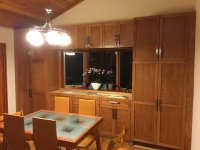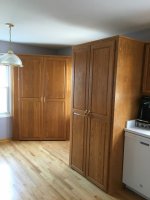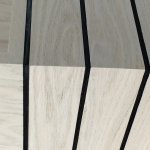So, I want to eventually build full wall hanging cabinetry in my laundry room. However, I thought I'd start with something my wife has been asking for which is to replace the laundry floor standing cheap plastic junk sink with a cabinet and new functional embedded sink. That way I can learn from my mistakes before embarking on a larger project.
I've done some research and am planning to use 2 side pre finished maple plywood for the project. A few questions pop up
1. Size -- What size makes sense - 3/4" or 1/2" for the plywood?
2. Top -- I'm going to have counter top area by the sink. Should I get a counter top specifically, or just glue something on top of the plywood? My has local wood store has pre finished wood counter tops close to the size, which would be awesome, but I'd be cutting out most of it for the sink which seems like a waste, but I also don't want to have to finish wood for being counter top ready if I don't have to. My finishing skills lag well behind my wood working skills.
3. Stability -- Any tips on stability?
4. Joints -- I'm thinking of using my domino 500 for joinery over the whole thing.
5. Hinges and shelves -- The LR32 system is too expensive since I'm a hobbyist and wouldn't be doing this beyond home projects. Is there a good inexpensive jig that's recommended for hinges? ( the ones on amazon have mixed reviews )? I do have a drill press and an OF1010 router ( and now recently a CXS with 35mm zobo ) so solutions for any of those are feasible.
6. Design - Any good designs for floor standing cabinets I should refer to? I notice there are varying recommendations on bases for floor standing cabinets.
Any information appreciated!
I've done some research and am planning to use 2 side pre finished maple plywood for the project. A few questions pop up
1. Size -- What size makes sense - 3/4" or 1/2" for the plywood?
2. Top -- I'm going to have counter top area by the sink. Should I get a counter top specifically, or just glue something on top of the plywood? My has local wood store has pre finished wood counter tops close to the size, which would be awesome, but I'd be cutting out most of it for the sink which seems like a waste, but I also don't want to have to finish wood for being counter top ready if I don't have to. My finishing skills lag well behind my wood working skills.
3. Stability -- Any tips on stability?
4. Joints -- I'm thinking of using my domino 500 for joinery over the whole thing.
5. Hinges and shelves -- The LR32 system is too expensive since I'm a hobbyist and wouldn't be doing this beyond home projects. Is there a good inexpensive jig that's recommended for hinges? ( the ones on amazon have mixed reviews )? I do have a drill press and an OF1010 router ( and now recently a CXS with 35mm zobo ) so solutions for any of those are feasible.
6. Design - Any good designs for floor standing cabinets I should refer to? I notice there are varying recommendations on bases for floor standing cabinets.
Any information appreciated!





